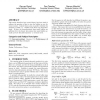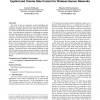76 search results - page 5 / 16 » Fluid model for window-based congestion control mechanism |
CCR
2005
13 years 7 months ago
2005
This article describes how control theory has been used to address the question of how to size the buffers in core Internet routers. Control theory aims to predict whether the net...
ICDCS
2006
IEEE
14 years 1 months ago
2006
IEEE
Distributed hash table (DHT) networks based on consistent hashing functions have an inherent load balancing problem. The problem becomes more severe due to the heterogeneity of ne...
CN
2007
13 years 7 months ago
2007
Receiver-driven TCP protocols delegate key congestion control functions to receivers. Their goal is to exploit information available only at receivers in order to improve latency ...
INFOCOM
2000
IEEE
13 years 12 months ago
2000
IEEE
— The packet losses imposed by IP networks can cause long and erratic recovery delays, since senders must often use conservative loss detection and retransmission mechanisms. Thi...
SENSYS
2009
ACM
14 years 2 months ago
2009
ACM
The state of the art congestion control algorithms for wireless sensor networks respond to coarse-grained feedback regarding available capacity in the network with an additive inc...


